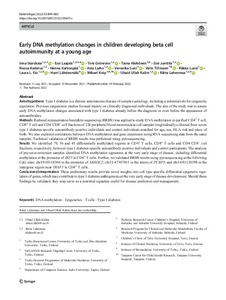Early DNA methylation changes in children developing beta cell autoimmunity at a young age
Junttila Sini; Tillmann Vallo; Kattelus Roosa; Starskaia Inna; Suni Veronika; Laajala Essi; Lund Riikka; Elo Laura L. Lähdesmäki Harri; Laiho Asta; Grönroos Toni; Lahesmaa Riitta; Kalim Ubaid Ullah; Knip Mikael; Kallionpää Henna; Härkönen Taina
https://urn.fi/URN:NBN:fi-fe2022081154409
Tiivistelmä
Aims/hypothesis
Type 1 diabetes is a chronic autoimmune disease of complex aetiology, including a potential role for epigenetic regulation. Previous epigenomic studies focused mainly on clinically diagnosed individuals. The aim of the study was to assess early DNA methylation changes associated with type 1 diabetes already before the diagnosis or even before the appearance of autoantibodies.
Methods
Reduced representation bisulphite sequencing (RRBS) was applied to study DNA methylation in purified CD4(+) T cell, CD8(+) T cell and CD4(-)CD8(-) cell fractions of 226 peripheral blood mononuclear cell samples longitudinally collected from seven type 1 diabetes-specific autoantibody-positive individuals and control individuals matched for age, sex, HLA risk and place of birth. We also explored correlations between DNA methylation and gene expression using RNA sequencing data from the same samples. Technical validation of RRBS results was performed using pyrosequencing.
Results
We identified 79, 56 and 45 differentially methylated regions in CD4(+) T cells, CD8(+) T cells and CD4-CD8- cell fractions, respectively, between type 1 diabetes-specific autoantibody-positive individuals and control participants. The analysis of pre-seroconversion samples identified DNA methylation signatures at the very early stage of disease, including differential methylation at the promoter of IRF5 in CD4(+) T cells. Further, we validated RRBS results using pyrosequencing at the following CpG sites: chr19:18118304 in the promoter of ARRDC2; chr21:47307815 in the intron of PCBP3; and chr14:81128398 in the intergenic region near TRAF3 in CD4(+) T cells.
Conclusions/interpretation
These preliminary results provide novel insights into cell type-specific differential epigenetic regulation of genes, which may contribute to type 1 diabetes pathogenesis at the very early stage of disease development. Should these findings be validated, they may serve as a potential signature useful for disease prediction and management.
Kokoelmat
- Rinnakkaistallenteet [19250]
